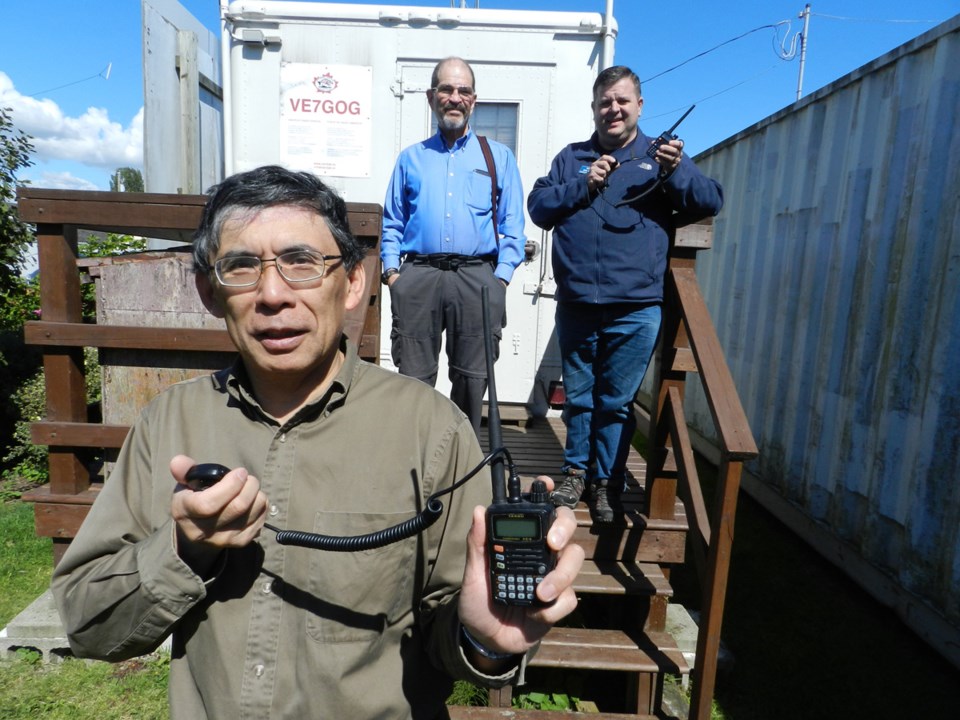The stereotype of the ham radio operator as a solitary figure reaching out over the airwaves to make contact gets turned on its head next weekend.
That’s when members of the Richmond Amateur Radio Club will be out in force at Garry Point Park during the annual Field Day event to take their place in a network of communicators during an emergency exercise. It’s a 24-hour test of how they can help make contact to relay information under disaster-like conditions. And Urey Chan, president of the club, and his fellow members are up for the challenge.
“It’s a good test of the club’s ability,” said Chan, 55, who works in marketing and communications. “The value in the exercise is learning how to improvise.”
Last year, when wind conditions at the park were blustery, club members had to be innovative and brace their flimsy antenna against their radio shack trailer. The plan worked and they continued their task of trying to make as many contacts with other ham radio operators as they could.
“In the event of an emergency, our radio station is fully self-contained,” said Eric Scott ,who has been a member of the club for the past seven years. “We can operate off a generator and with the antennas we have, we can basically talk worldwide.
“In the event of something serious going on, we can set up as a communications point,” he added. “So, it’s kind of a contest. But it’s more of an exercise to see what happens if, for some reason, there’s no (communications) infrastructure.”
The Field Day is also a chance to implement the skills Scott first picked up as a youngster when his uncle, a ham radio operator, gave his younger brother a shortwave radio as a present.
“My brother played with it for about two minutes, lost interest and I loved that thing,” Scott said, adding the radio eventually became his.
Scott, an IT worker, said the appeal for being a ham radio operator during the Field Day is his like of tinkering.
“It’s probably one of my favourite events,” Scott said. “It’s always unique with what you hear out there and who you talk to.”
Chan, who first got exposed to ham radios as an air cadet in early 1970s west Montreal, said he enjoys the social side of radio.
“I never got back to it (ham radios) until my brother-in-law took me to a huge convention in Dayton, Ohio. Plus, electronics is my weakest subject.”
That was five years ago and Chan has not looked back.
“I realized there’s a lot more to it than just electronics. There’s community service, the emergency communications aspect, and we do a lot of volunteer work supporting activities,” Chan said.
Part of that is helping out with communications during the annual Steveston Salmon Festival parade on Canada Day.
“We help provide the eyes and ears on that day,” he said.
For Charles Cohen, a club member and semi-retired physicist who came to ham radios later in life as means of communicating with his wife while sailing, he appreciates the connectedness the hobby provides.
“It gives me a way to talk to people that is independent of the phone system,” Cohen said. “There’s no infrastructure. It’s my antenna and your antenna. I’m technically inclined and get a kick out of figuring out how far I can go (communicate) on as little power as possible.
“It’s neat to be here and hear a signal from France, send something back and get a response.”
One landmark activity the club got involved with a couple of years ago was connecting local high school students with astronauts aboard the International Space Station, orbiting 300 km above them.
“We were there inspiring, if you will, all these high school kids who have an interest in the sciences. And they were able to talk to astronauts using ham radio technology,” Chan said. “I thought, wow, this is really cool.”
The Richmond club currently has 30 members, ranging from a woman in her 90s, who was a radio operator during the Second World War, to scouting-age youngsters.
“It’s a hobby that’s not restricted to age, primarily because it’s not physically demanding. It’s mentally challenging,” Chan said. “And as far as the community is concerned, it’s a way of providing support.”
For more about the Richmond Amateur Radio Club, visit online at RarClub.ca.



